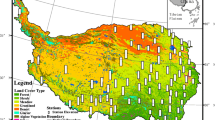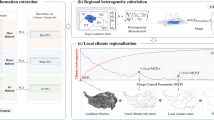Abstract
The knowledge of contemporary climatic change over the Qinghai-Xizang (Tibet) Plateau (QXP) has been inadequate for a long time due to lack of enough observational data. In this paper, on the basis of monthly temperature and precipitation data in 1961–1990 from 48 stations on the QXP, the temperature data are extended backward to 1901 with an empirical orthogonal function (EOF) method, microscopic characteristics of contemporary climatic change over the QXP are analyzed, and the response of the plateau climate to global warming is discussed in combination with atmospheric general circulation model (GCM) outputs. The results show that the plateau climate, as a whole, has been warming since the early part of this century, that the precipitation has generally been increasing during the recent 30 years, and that these climatic trends seem to be related to the enhanced green-house effect induced by increasing CO2 concentration in the atmosphere.
Similar content being viewed by others
References
Boden T. A., D. P. Kaiser, R. J. Sepanski, F. W. Stoss (Eds.), 1994. Trends’ 93: A Compendium of Data on Global Change. CDIAC, Oak Ridge National Laboratory, 622–623.
Enting I. G., T. M. L. Wigley, M. Heimann (Eds.), 1994. Future Emissions and Concentrations of Carbon Dioxide: Key Ocean/Atmosphere/Land Analyses. Commonwealth Scientific and Industrial Research Organization, Aspendale, Australia, CSIRO Division of Atmospheric Research Technical Paper No. 31.
Houghton J. T., G. J. Jenkins J. J. Ephraums, 1990. Climate Change: The IPCC Scientific Assessment. Cambridge: Cambridge University Press, 1–365.
Jones P. D., K. R. Briffa, 1992. Global surface air temperature variations over the twentieth century: Part 1, Spatial, temporal and seasonal details. Holocene, 2: 105–179.
Kang Xingcheng, 1992. An exploration of historical climatic change over Qilian mountain. Special Research Issue of Lanzhou Institute of Glaciology and Geocryology, Chinese Academy of Sciences, No. 7. Beijing: Science Press, 54–63. (in Chinese)
Kutzbach J. E., 1967. Numerical eigenvectors of sea-level pressure, surface temperature and precipitation complexes over North America. J. Appl. Meteor., 16: 791–802.
Manabe S., R. J. Stouffer, M. J. Spelman et al., 1991. Transient response of a coupled ocean-atmosphere model to gradual changes of atmospheric CO2. Part I: Annual mean response. J. Climate, 4: 785–818.
Tu Qipu, 1986. A method of extending an time series sequence of air temperature. J. Nanjing Institute Meteor., 9: 19–30. (in Chinese)
Ye Duzheng, Gao Youxi, 1979. The Meteorology of the Qinghai-Xizang (Tibet) Plateau. Beijing: Science Press, 1–278. (in Chinese)
Author information
Authors and Affiliations
Additional information
This work is supported by the National and CAS (the Chinese Academy of Sciences) Tibet Research Project.
Rights and permissions
About this article
Cite this article
Liu, X., Zhang, M. Contemporary climatic change over the qinghai-xizang plateau and its response to the green-house effect. Chin. Geograph.Sc. 8, 289–298 (1998). https://doi.org/10.1007/s11769-997-0034-9
Received:
Issue Date:
DOI: https://doi.org/10.1007/s11769-997-0034-9




